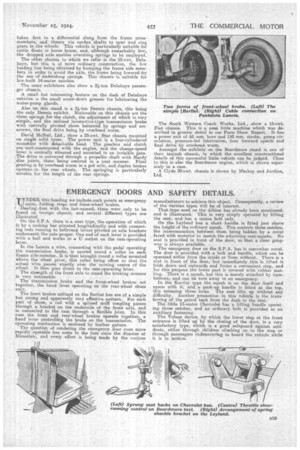EMERGENGY DOORS AND SAFETY DETAILS.
Page 23

If you've noticed an error in this article please click here to report it so we can fix it.
TINDER this heading we includrasuth points as emergency e IL) exits; folding steps and front-wheel brakes. Dealing_first with the last-named, these were only to be found on foreign chassis, and several different types are illustrated.
• On the S.P.A. there is a neat type, the 'operation of which is by a rocking bar situated longitudinally and with connecting rods running to belkrank levers pivoted on axle brackets underneath the axle proper. One end of each lever is provided with a ball and works in a U socket on the cam-operating lever.
In the Lancia a wire, connecting with the pedal operating the transmission brake, is carried round a roller on each frame side-member. It is 'thenbrought; round a roller mounted above the wheel pivot, this roller being offset so that the actual wire passes exactly Over the turning centre of the wheel. It then goes direct to the cam-ciperatang lever. The strength of the front axle to stand the braking stresses is very noticeable.
• The transmission brake and the front-wheel brakes act together, the hand lever operating on the rear-wheel shoes only.
The front brakes utilized on the Bernet bus are of a simple but strong and apparently very effective pattern. For each pair of shoes, a sod with a splined muff coupling passes through a bracket on the underside of the front axle, and is connected to the cam through a flexible joint. In this case the front and rear-wheel brakes operate together, a hand lever controlling the brake on the transmission. The operating mechanism is enclosed by leather gaiters.
The question of rendering the emergency door even more rapidly operable has come to the fore since the disaster at Nuneaton, and every effort is being Made by the various manufacturera to achieve this object. Consequently, a review of the various types will be of interest. That type used on the Albion has already been mentioned, and is illustrated. This is very simply operated by lifting the seat, -and has a centre bolt only.
On the Leyland bus a short handle is fitted just above the height of the ordinary squab. This controls three catches, the interconnection between them being hidden by a cover faced with material to match the adjoining seat-squabs. No seat is provided in front of the door, so that a clear gangway is always available. The emergency deer on the S.P.A. bus is somewhat novel. The doer is provided with a lock and handle, which can be operated either from the inside or from without. There is a seat in front of the door, but immediately this is lifted it folds down and outwards and forms a convenient step, and for this purpose the lower part is covered with rubber matting. There is a squab, but this is Merely attached by turnbuttons, and can be torn away in an emergency. In the Karrier type the squab is on the -door itself and opens with it, and a push-up handle is fitted at the top, this releasing three • locks The seat lifts up without any difficulty. Another precaution in this vehicle is the transferring of the petrol tank from the dash to the rear. The little 13-seater Chevrolet has a lifting handle operating three catches, and an ordinary bolt is provided as an auxiliary fastening.
The Vulcan device, by which the lower step at the front entrance is lifted up by the closing of the door, is a very satisfactory type, which is a good safeguard against accidents, either through children climbing on to the step or through passengers endeavouring to board the vehicle while it is in motion.


































